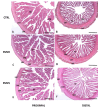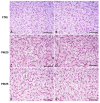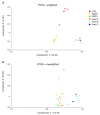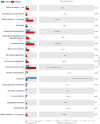The Replacement of Fish Meal with Poultry By-Product Meal and Insect Exuviae: Effects on Growth Performance, Gut Health and Microbiota of the European Seabass, Dicentrarchus labrax
- PMID: 38674688
- PMCID: PMC11052083
- DOI: 10.3390/microorganisms12040744
The Replacement of Fish Meal with Poultry By-Product Meal and Insect Exuviae: Effects on Growth Performance, Gut Health and Microbiota of the European Seabass, Dicentrarchus labrax
Erratum in
-
Correction: Rimoldi et al. The Replacement of Fish Meal with Poultry By-Product Meal and Insect Exuviae: Effects on Growth Performance, Gut Health and Microbiota of the European Seabass, Dicentrarchus labrax. Microorganisms 2024, 12, 744.Microorganisms. 2024 Jul 25;12(8):1524. doi: 10.3390/microorganisms12081524. Microorganisms. 2024. PMID: 39203585 Free PMC article.
Abstract
This study addressed the urgent need for sustainable protein sources in aquaculture due to the depletion of marine resources and rising costs. Animal protein sources, particularly poultry by-product meal (PBM) and insect exuviae meal, were investigated as viable alternatives to fishmeal (FM). The research study confirmed the successful replacement of FM with a combination of PBM and insect exuviae meal (up to 50%) in the diet of European seabass without compromising growth, feed conversion, gut health, and liver fat content. In particular, growth was robust with both PBM formulations, with the 25% PBM diet showing better results. Histological examinations showed good gut and liver health, contradicting the concerns of previous studies. This paper emphasizes the importance of holistic analyzes that go beyond growth parameters and include histomorphological investigations. The results show that PBM in combination with insect/exuviae meal is well tolerated by seabass, which is consistent with reports in the literature of it mitigating negative effects on gut health. A detailed analysis of the microbiota revealed a decrease in the Firmicutes/Proteobacteria ratio due to an increase in potentially pathogenic bacteria. However, the formulation containing insect exuviae partially counteracted this effect by preserving the beneficial Lactobacillus and promoting the synthesis of short-chain fatty acids (SCFAs), particularly butyrate. Chitin-rich components from insect exuviae were associated with improved gut health, which was supported by the increased production of SCFAs, which are known for their anti-inflammatory properties. This paper concludes that a combination of PBM and insect/exuviae meal can replace up to 50% of FM in the diet of seabass, supporting sustainable aquaculture practices. Despite some changes in the microbiota, the negative effects are mitigated by the addition of insect exuviae, highlighting their potential as a prebiotic to increase fish productivity and contribute to a circular economy in aquaculture.
Keywords: exuviae; gut microbiota; insect meal; poultry meal; seabass.
Conflict of interest statement
The authors declare no conflicts of interest.
Figures







References
-
- Tacon A.G.J., Metian M. Fishing for aquaculture: Non-food use of small pelagic forage fish-a global perspective. Rev. Fish. Sci. 2009;17:305–317. doi: 10.1080/10641260802677074. - DOI
-
- Oliva-Teles A., Enes P., Peres H. Feed and Feeding Practices in Aquaculture. Woodhead Publishing; Cambridge, UK: 2015. Replacing fishmeal and fish oil in industrial aquafeeds for carnivorous fish; pp. 203–233. - DOI
-
- Daniel N. A review on replacing fish meal in aqua feeds using plant protein sources. Int. J. Fish. Aquat. Stud. 2018;6:164–179.
-
- Yu Y. Alternative Protein Sources in Aquaculture Diets. CRC Press; Boca Raton, FL, USA: 2008. Replacement of fish meal with poultry by-product meal and hydrolyzed feather meal in feeds for finfish; pp. 51–93.
-
- Cheng Z., Hardy R.W. Apparent digestibility coefficients of nutrients and nutritional value of poultry by-product meals for rainbow trout Oncorhynchus mykiss measured in vivo using settlement. J. World Aquac. Soc. 2002;33:458–465. doi: 10.1111/j.1749-7345.2002.tb00025.x. - DOI
Grants and funding
- project codex N. F/200078/01-03/X45, CUP B41B20000280005/PON-MISE I&C 2014-2020 FESR, ASSE I -Innovazione e Azione, Azione 1.1.3. D.M. 05/03/2018
- Protocollo nr: 414352 - del 07/12/2023/I-FISH. AOO_IAI - AOO_Incentivi Fondo per la Crescita Sostenibile - Accordi per l'innovazione di cui al D.M. 31 Dicembre 2021 e D.D. 14 Novembre 2022. Impresa: VRM S.R.L. (C.F. 02779360243) - Capofila
LinkOut - more resources
Full Text Sources

